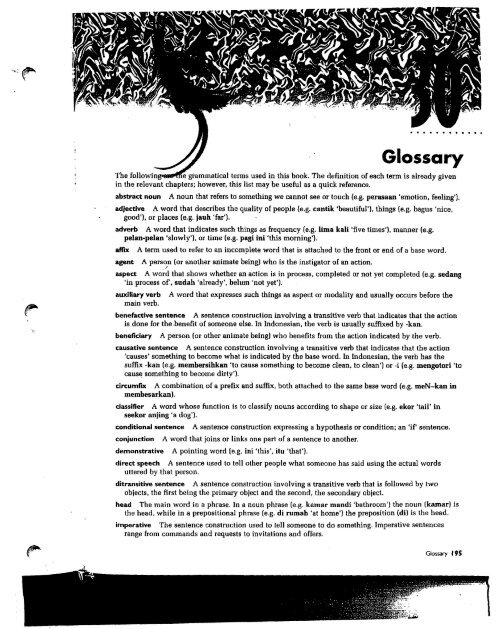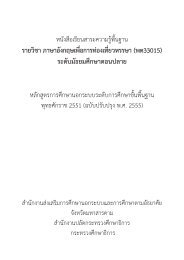bahasa indonesia
djenar-2003-a-students-guide-to-indonesian-grammar-oxford
djenar-2003-a-students-guide-to-indonesian-grammar-oxford
- No tags were found...
You also want an ePaper? Increase the reach of your titles
YUMPU automatically turns print PDFs into web optimized ePapers that Google loves.
. * * . * * * . * * * ,<br />
Glossary<br />
The followindgtammatical terms used in this book. The definition of each term is already given<br />
in the relevant chapters; however, this list may be useful as a quick reference.<br />
abstract noun A noun that refers to something we cannot see or touch (e.g. perasaan 'emotion, feeling').<br />
adjective A word that describes the quality of people (e.g. cantik 'beautiful'), things (e.g. bagus 'nice,<br />
good*), or places (e.g, jauh 'far').<br />
adverb A word that indicates such things as frequency (e.g. Lima kali 'five times'), manner (e.g.<br />
pelan-pelan 'slowly'), or time (e.g. pagi ini 'this morning').<br />
affix A term used to refer to an incomplete word that is attached to the front or end of a base word,<br />
agent A person (or another animate being) who is the instigator of an action.<br />
Z<br />
aspect A word that shows whether an action is in process, completed or not yet completed (e.g. sedang<br />
'in process of, sudah 'already', belum 'not yet').<br />
auxiliary verb<br />
main verb.<br />
A word that expresses such things as aspect or modality and usually occurs before the<br />
benefactive sentence A sentence construction involving a transitive verb that indicates that the action<br />
is done for the benefit of someone else. In Indonesian, the verb is usually suffixed by &an.<br />
beneficiary A person (or other animate being] who benefits from the action indicated by the verb.<br />
causative sentence A sentence construction involving a transitive verb that indicates that the action<br />
'causes' something to become what is indicated by the base word. In Indonesian, the verb has the<br />
suffix -kan (e.g. membersihkan 'to cause something to become clean, to clean') or -i (e.g. mengotori 'to<br />
cause something to become dirty*).<br />
circumfix A combination of a prefix and suffix, both attached to the same base word (e.g. meN-kan in<br />
mernbesarkan).<br />
classMer A word whose function is to classify nouns according to shape or size (e.g. ekor 'tail' in<br />
seekor anjing 'a dog').<br />
conditional sentence<br />
A sentence construction expressing a hypothesis or condition; an 'if' sentence.<br />
conjunction A word that joins or links one part of a sentence to another.<br />
demonstrative<br />
A pointing w'ord (e.g. ini 'this', itu 'that').<br />
direct speech A sentence used to tell other people what someone has said using the actual words<br />
uttered by that person.<br />
ditransitive sentence A sentence construction involving a transitive verb that is followed by two<br />
objects, the first being the primary object and the second, the secondary object.<br />
head The main word in a phrase. In a noun phrase (e.g. kamar mandi 'bathroom') the noun [kamar) is<br />
the head, while in a prepbsitional phrase [e.g. di rumah 'at home*) the preposition (di) is the head.<br />
imperative The sentence construction used to tell someone to do something. Imperative sentences<br />
range from commands and requests to invitations and offers.<br />
p Glossary 195



